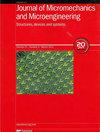利用驻留声场中的声学粒子间力进行细胞诱捕的三维 FSI 模拟
IF 2.1
4区 工程技术
Q2 ENGINEERING, ELECTRICAL & ELECTRONIC
引用次数: 0
摘要
近年来,利用声学方法进行细胞分离和分拣的微流体设备在生物医学应用领域取得了重大发展。声学粒子间力(AIF)或次级声学辐射力来自粒子与其他粒子散射场的相互作用,影响粒子在近距离的运动,促进最佳捕获和分离。本研究利用流固耦合(FSI)分析了一个由固定颗粒和白细胞(WBC)组成的双颗粒系统,该系统处于静止声场和蠕动流中。为了通过解耦声学和 FSI 降低计算成本,在频域上求解了声压方程,以计算每个时间步中的总声学辐射力。通过评估聚苯乙烯颗粒上的颗粒间(AIF)和原声辐射力(ARF),并将模拟结果与分析和实验数据进行比较,评估了模型的准确性。结果表明,原生 ARF 计算精确,AIF 的差异归因于颗粒表面附近的粘性损失。此外,与白细胞相比,固定颗粒的密度更高,因此在近距离内颗粒间会产生显著的声学吸引力。因此,在雷诺数为 1.4 × 10-3、2.1 × 10-3 和 3 × 10-3 的蠕动流中,通过与固定铝和硅粒子的强烈吸引和碰撞,细胞会被截留。雷诺数越大,细胞与固定颗粒分离的可能性就越大。这些发现有助于优化细胞分离和夹持策略。本文章由计算机程序翻译,如有差异,请以英文原文为准。
Three-dimensional FSI simulation of cell entrapment utilizing acoustic interparticle force in a standing acoustic field
In recent years, there has been significant development in microfluidic devices for cell separation and sorting using acoustic methods in biomedical applications. The acoustic interparticle force (AIF) or the secondary acoustic radiation force arises from particle interactions with the scattered field of other particles, influencing particle motion at close ranges and facilitating optimal trapping and separation. This study analyzes a two-particle system consisting of a fixed particle and a white blood cell (WBC) within a standing acoustic field and creeping flow using fluid-structure interaction (FSI). To reduce computational costs by decoupling the acoustics and FSI, the acoustic pressure equation was solved on the frequency domain to calculate the total acoustic radiation force in each time step. Model accuracy was assessed by evaluating interparticle (AIF) and primary acoustic radiation force (ARF) on a polystyrene particle and comparing simulation results to analytical and experimental data. Results demonstrate the precise primary ARF computation, with discrepancies in AIF attributed to viscous losses near the particle surface. Moreover, the higher density of the fixed particle compared to WBCs induces significant acoustic interparticle attraction at close distances. Consequently, cell entrapment occurs through strong attraction and collision with fixed aluminum and silicon particles in creeping flow in all three Reynolds numbers 1.4 × 10−3, 2.1 × 10−3, and 3 × 10−3. Increasing Reynolds numbers augment the likelihood of cell separation from the fixed particle. These findings contribute to optimizing cell isolation and entrapment strategies.
求助全文
通过发布文献求助,成功后即可免费获取论文全文。
去求助
来源期刊

Journal of Micromechanics and Microengineering
工程技术-材料科学:综合
CiteScore
4.50
自引率
4.30%
发文量
136
审稿时长
2.8 months
期刊介绍:
Journal of Micromechanics and Microengineering (JMM) primarily covers experimental work, however relevant modelling papers are considered where supported by experimental data.
The journal is focussed on all aspects of:
-nano- and micro- mechanical systems
-nano- and micro- electomechanical systems
-nano- and micro- electrical and mechatronic systems
-nano- and micro- engineering
-nano- and micro- scale science
Please note that we do not publish materials papers with no obvious application or link to nano- or micro-engineering.
Below are some examples of the topics that are included within the scope of the journal:
-MEMS and NEMS:
Including sensors, optical MEMS/NEMS, RF MEMS/NEMS, etc.
-Fabrication techniques and manufacturing:
Including micromachining, etching, lithography, deposition, patterning, self-assembly, 3d printing, inkjet printing.
-Packaging and Integration technologies.
-Materials, testing, and reliability.
-Micro- and nano-fluidics:
Including optofluidics, acoustofluidics, droplets, microreactors, organ-on-a-chip.
-Lab-on-a-chip and micro- and nano-total analysis systems.
-Biomedical systems and devices:
Including bio MEMS, biosensors, assays, organ-on-a-chip, drug delivery, cells, biointerfaces.
-Energy and power:
Including power MEMS/NEMS, energy harvesters, actuators, microbatteries.
-Electronics:
Including flexible electronics, wearable electronics, interface electronics.
-Optical systems.
-Robotics.
 求助内容:
求助内容: 应助结果提醒方式:
应助结果提醒方式:


